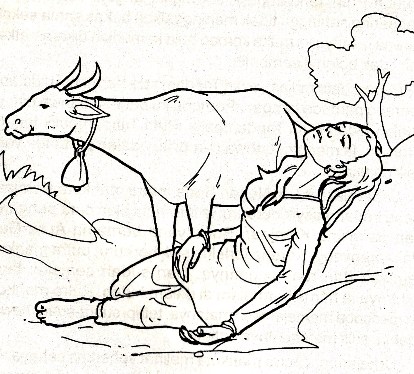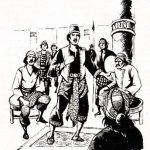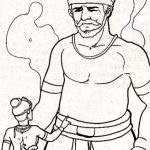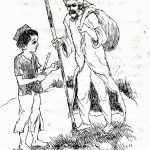
The Jombang Taste greets you back with the articles of Batak folklore. This time the writer shares the origins of saringgon. Once upon a time in the Batak area, the area around the province of North Sumatra, there lived a king who had six wives. Even though the king had six wives, none of his six wives had children. Therefore the king remarried his seventh wife.
Batak folklore says that about a year later his seventh wife gave birth to a son. The child was given the name The King of Omas. Since being blessed with that child, the King and his seventh wife have been very happy. On the other hand, the six wives of the King who did not have children were very jealous at the birth of the King Omas.
Therefore one night they stole the Omas King and they put it in a large pumpkin that had been emptied. Then they washed the big gourd into the river.
The next day an old woman who was fishing in the river saw the big pumpkin drifting. Interested to see it, the old woman took the pumpkin and brought it home. The old woman was very happy when she found a baby in the big pumpkin.
In all her life until her husband died, she never had children. So the King of Omas is nurtured with great affection like his own biological child. The folklore of North Sumatra states that after growing up as a young man, the King of Omas worked tapping sugar palm to extract the sap.
The sap is turned into palm wine and he sells it in a shop he has built near his house. The tuak that Si Raja Omas sells is very special, so it is famous everywhere. From various places, people came to drink tuak at the King Omas shop. The folklore of North Sumatra continues with the life of Si Raja Omas.
The origin of Saringgon
The crowd came to drink tuak at the King Omas shop after the story broke that the King of Omas had a small gong called mongmongan. When the mongmongan is sounded, his voice says like a human and says that the one who has mongmongan is named Si Raja Omas, a special tuak seller.
Meanwhile, in other Batak areas there was news that the King, the father of Si Raja Omas, had been ill for a long time. One time he got the news that in a village there was someone selling tuak which was very special. The folklore of North Sumatra states that the King ordered someone to immediately go buy it. After the king drank the tuak, his illness was immediately cured, then the king met the tuak seller.
When the King arrived at the Omas King’s shop, it happened that the Omas King sounded his mongmong to cheer up the people who were drinking tuak in his shop. As usual the mongmongan made a sound that resembled a person speaking. It read, “Look, the King has come to drink the palm wine of the Omas King.”
Hearing the mongmongan voice, the King knew that the young man who sold the tuak was his son, the King of Omas, who had disappeared when he was a child. With a very happy feeling, the King told the Omas King that he was his son. To find out whether the king’s words were true or not, the King of Omas invited the king to meet an old woman whom he considered his biological mother so far.
When they met the old woman told her about the origin of the Omas King. With the excuse of repaying the old woman’s favor, the King allowed the King of Omas to stay together, until the time when the King of Omas was crowned king to replace him. The legend of the origin of saringgon continues.
One day the old woman told the King of Omas to go to take a bath in a lake in the middle of the forest. Batak folklore states that when the King of Omas arrived near the lake, he saw seven very beautiful girls bathing. Their clothes lie on a bush that grows on the edge of the lake. Secretly, the Omas King took one of the clothes and hid it.
The seven beautiful maidens are daughters of gods who came down from heaven to bathe on earth. After taking a bath, they put on their own clothes and flew back to heaven. However, one of them, the youngest one, could not fly back to heaven. It is stated in the story of the origin of saringgon that because his clothes had been taken and hidden by the Omas King. Finally, the King Omas married the youngest daughter of the god.
Even though she had become the wife of the King Omas, the god’s daughter was looking for his clothes that the Omas King hid so he could return to heaven. A year later, their child was born. According to Si Raja Omas, because they already have children, their wives will not want to return to heaven anymore. Therefore, he was no longer always watching over his wife. Thus, his wife got more opportunities to find clothes that were hidden by the Omas King.
One day, the wife succeeded, the King of Omas found her clothes that her husband had been hiding for a long time. She immediately put the clothes on and then she hurriedly took their child who was sleeping on the swing. However, the King of Omas quickly took the child and tried to catch his wife. Deftly, his wife dodged and flew in circles over the house.
Seeing his wife doing this, the King of Omas immediately took a potion that didn’t smell good and used the potion to stain his son’s face. The King of Omas did this so that his wife would not dare to take the child. In the legendary story of the Saringgon from the Batak, it is stated that his wife really hated herbs that did not smell good.
Not long after, the wife of the King of Omas flew into the sky. However, his parents did not allow him to enter heaven because he had lived in the world for too long. Therefore, the wife of the King Omas turned into a saringgon, a roaring wind that blew heavy rain.
Since then, whenever the mothers in Simatungun hear saringgon, they immediately smear the faces of their babies or young children with an unpleasant smell. They imitated the actions of the King of Omas in order to save their child from the heavenly daughter who had transformed into saringgon.
That is the origin of saringgon which is obtained from the legend of the King of Omas. The moral message of this Batak folklore is not to keep lies in life because it can cause problems later. The mandate of this North Sumatra folklore is that we always prioritize honesty in associating with fellow humans. Hopefully the legend of this Saringgon can add to your insight.
References:
Hidayat, Kidh 2008. Folk tales throughout the archipelago. Jakarta: Indonesian literature.
Abdulwahid, et al. 2008. Codification of Folklore in Pangandaran Tourism Area, West Java. Bandung: Center for Language Development and Development of the Ministry of Education and Culture.
Lubis, Panguhan Z. 1996. Folklore from Simalungun (North Sumatra). Jakarta: Grasindo.
Rahimsyah. 2001. Collection of Folklore and National History. Surabaya: It was bright.
Reza, Marina Asril. 2008. Best Story Original Archipelago. Jakarta: Visimedia.
Optima Pictures team. 2010. Archipelago Stories Collection of Tales, Epic, Fables, Legends, Myths and History. Jakarta: TransMedia.



Tinggalkan Balasan